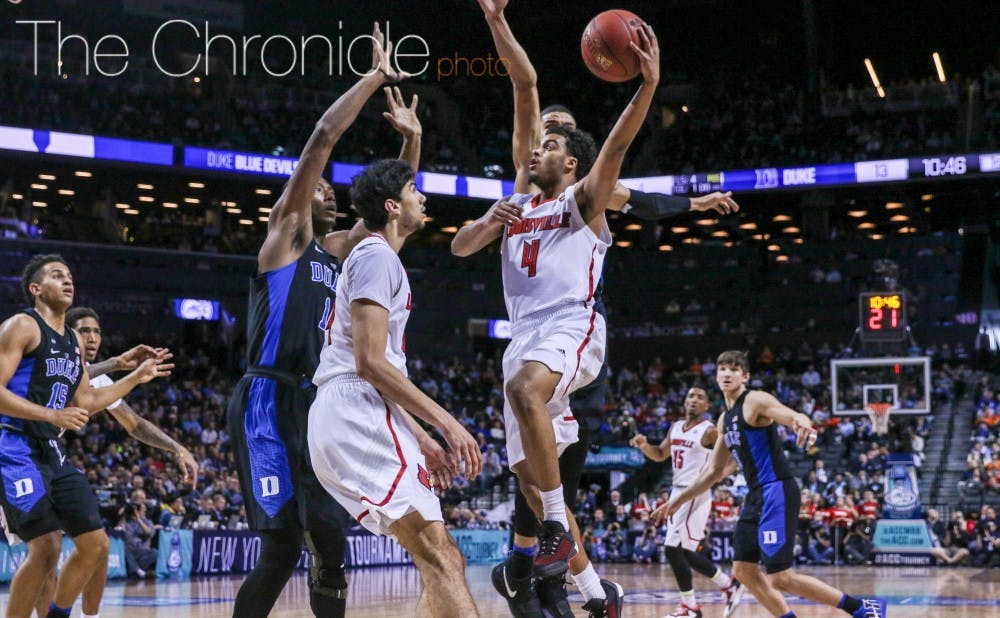NEW YORK—With the Blue Devils running on fumes to start the second half of their second game in as many days, not even strong defenders Matt Jones and Frank Jackson could match up with Louisville’s quick guards one-on-one.
Head coach Mike Krzyzewski looked down his bench with his team trailing 61-49 and decided the answer was not Amile Jefferson, Duke’s defensive anchor in the frontcourt who sat out most of the second half due to fatigue. Instead, he looked to freshman Marques Bolden, who had not played up to that point but entered the game and brought a switch to a 2-3 zone with him.
Bolden recorded no stats aside from one foul in four minutes, but his presence in the middle of the zone immediately cut off the Cardinals’ easy looks at the rim and set the tone for a comeback in the Blue Devils’ 81-77 win.
Duke had not used a zone much this season, but the tactical adjustment helped conceal its fatigue.
“They attacked us so much in the start of the second half, we were on the bottom of a hill covered with snow catching a sled,” Krzyzewski said. “We just had to do something to stop momentum.”
Freshman forward Harry Giles also played 15 minutes—his most action in four games—and helped bolster his team’s defense with two steals and a block. By the time Jefferson returned to the floor with 6:18 left after more than a 10-minute rest, the Blue Devils’ two freshmen big men had helped trim the deficit to two.
With star players Jayson Tatum and Luke Kennard each playing at least 38 minutes for the fifth time in six games, the contributions off the bench seemed to give the Duke defense life even if Giles and Bolden did not generate much offensive.
“They gave us a lift, an amazing verve off the bench,” Jefferson said. “Our guys really showed today that we have eight guys strong that can really make an impact on the game.”
After Louisville started the second half 9-of-14 from the field and scored on 10 of its first 12 possessions, it missed 10 of its last 14 shots. The zone gave the Blue Devils help under the basket and forced the Cardinals to dish passes out to the perimeter, where they could not capitalize, shooting just 3-of-13 from the outside in the second half.
First-team All-ACC guard Donovan Mitchell had one of his worst games of the season, scoring just eight points on 3-of-14 shooting. The dynamic scorer—who shoots 37.1 percent from deep on the year—had several open looks that could have stretched the zone, but was off the mark from the perimeter.
“We had an awareness on him,” Jones said. “He’s a really good player, and we just tried to limit his mobility in the offense.”
Krzyzewski’s team used the same formula to beat the Cardinals two years ago, holding Louisville to 4-of-25 shooting from deep in a game that wound up being the turning point in the 2015 team’s run to the national championship.
But Duke went to the zone from the outset that afternoon as a big part of its gameplan. The move was more spontaneous Thursday, part of a season full of on-the-fly adjustments. Jones, who made the All-ACC defensive team this year, said after the game he could not remember the last time the Blue Devils practiced a zone.
“That’s just where Coach saw the game going. Coach has been in that situation before. We had to switch it up because we were giving them too many layups,” Jones said. “[Man-to-man] was what we were built off of, but obviously in moments, it works, and today it worked for us.”
The zone and the Cardinals’ shot-happy tendencies down the stretch also helped create more offense for Duke.
Louisville’s misses from deep created a lot of long rebounds, and many of them went to sophomore guard Luke Kennard, who notched his first double-double of the season.
“The key in the second half was the defensive rebounding from our perimeter, which led to us fast-breaking,” Krzyzewski said. “They were fast-breaking, and now we were fast-breaking.”
The Blue Devils tied the game at 64 when Kennard grabbed a rebound off a missed 3-pointer by Quentin Snider, took it down the floor himself and pulled up for a triple. After the Cardinals recovered and opened up a four-point lead again, Kennard did the same thing off a defensive rebound to trim the deficit to one. Duke outscored Louisville 14-6 in fast-break points, quickly turning the tables on the Cardinals’ transition attack.
The Blue Devils have a few extra hours to rest before Friday night’s marquee semifinal matchup against North Carolina than they did heading into Thursday’s game.
But if they run out of gas against the Tar Heels’ fast-paced offense, Krzyzewski may consider reaching into his back pocket for a defensive switch again.
“That zone helped us to not allow them to keep just dropping the ball down there and getting easy buckets,” Jefferson said. “Those little changes, the little nuances we made throughout the game allowed us and helped us to get the win.”
Get The Chronicle straight to your inbox
Signup for our weekly newsletter. Cancel at any time.

